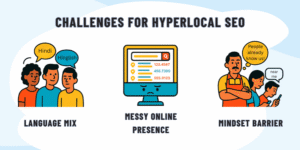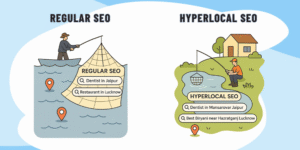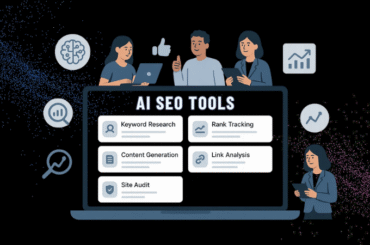Step into the lanes of Surat, Lucknow, or any other tier-2 city, and you will notice lively cafes, buzzing cafes, and coaching centers filled with eager students. But try searching for these businesses online, and the story changes. Many of them don’t even appear, and those that do often have half-filled Google listings.
According to the Digital 2025 India Report, India had 806 million internet users as of January 2025, and nearly two-thirds of new online shoppers now come from tier-2 and tier-3 cities. These are everyday people who aren’t looking for global brands—they’re simply pulling out their phones to type queries like “best biryani near me” or “coaching classes in Vijay Nagar.”
That’s precisely where hyperlocal SEO makes all the difference. Instead of competing for crowded national keywords, it allows local businesses to appear in searches that actually matter —the ones made by customers in their own neighborhoods, right when they’re ready to make a decision. Let us explore all about hyperlocal SEO and how it is winning in small cities and tier-2 markets.
Source: Datareportal
What Do We Mean by Hyperlocal SEO?
Think of regular SEO as casting a net across an entire ocean. Hyperlocal SEO is more like fishing in a pond behind your house. It’s focused, specific, and typically yields quicker results.
For example:
- Instead of targeting “dentist in Jaipur,” hyperlocal SEO goes after “dentist in Mansarovar Jaipur.”
- Instead of “restaurant in Lucknow,” it’s “best biryani near Hazratganj Lucknow.”
See the difference? The second set of searches is far more intent-driven. These are people who are ready to buy, visit, or call.
Why Does It Work Better in Smaller Cities?
Aren’t you curious to know why hyperlocal SEO is winning in smaller cities and Tier 2 markets compared to metropolitan cities and Tier 1 markets? Then, satiate your curiosity by reading these reasons:
1. Less Competition, Faster Wins
In metros, everyone is fighting for visibility. In smaller markets, you’ll be surprised at how many businesses don’t even have a proper website. That means if you do the basics right, you can leapfrog to the top.
2. Internet Growth in Tier-2 Markets
Jio, cheap smartphones, and regional content have changed the game. According to a report by Kantar, almost half of India’s active internet users now come from tier-2 and smaller cities. These users are not just browsing; they’re searching, buying, and booking online.
3. People Trust “Local”
In smaller towns, people want a face they can trust. A business that appears consistently in search results, with good reviews and local relevance, feels safer than an unknown brand.
4. Voice and Vernacular
Here’s something many don’t realize: voice search is booming in these cities. And people often search in Hindi or regional languages. If your bakery in Kanpur is optimized for “cake shop near me” in Hinglish, you’re already ahead of most.
Steps to Build a Strong Hyperlocal SEO Strategy
If you are eager to know how to build a hyperlocal SEO strategy for your business, then here are the steps worth considering:
1. Claim Your Google Business Profile
If you’re running a shop, café, or coaching center, this is the first box you need to tick. Your Google Business Profile (GBP) is what appears when someone searches for “near me” or asks Google Maps for directions. If you don’t show up there, it’s almost like your business doesn’t exist online.
Next Step: Add your shop’s name, address, and phone number—the same information should be used across all platforms. Upload real pictures (your storefront, team, food, or products). People trust what they can see. Keep your services clear and up-to-date. And yes, encourage happy customers to drop reviews, while replying politely to the negative ones.
2. Think in Local Keywords
Most business owners overthink SEO. You don’t need to rank for “best institute in India.” Instead, you should rank for what your customers type when they need you. For example:
- “Coaching classes near Vijay Nagar Indore”
- “24-hour chemist shop Hazratganj Lucknow”
- “Car mechanic near Jagatpura, Jaipur”
These may seem like small searches, but they attract serious buyers who are ready to act.
Action Tip: Listen to how your customers ask questions on calls or in person. Jot those down and sprinkle them into your website pages, headings, and Google Business Profile.
3. Create Content with Local Flavor
This is where small-city businesses can shine. People don’t want generic blogs that could come from anywhere. They want to feel that you’re part of their world. A mithai shop in Patna writing about “Top sweets for Chhath Puja” will always connect better than a dry post on “Benefits of eating sweets.”
Try This: Post about local festivals, events, or customer stories. Use real photos from your store or team. If you’re a café, share behind-the-scenes videos of how you prepare something special for Diwali. These little touches make you relatable and memorable.
4. Build Local Links
You don’t need backlinks from giant websites. What works better is local credibility. A mention in your city’s online newspaper, a community blog, or even a tie-up with another neighborhood business can give you the push you need.
Example: A café and a bookstore nearby can team up, promoting each other’s websites and social media. That way, both tap into each other’s audience.
Do This: Look for city directories, collaborate with local businesses, and don’t shy away from community events; they often give you a free online shoutout.
5. Make Your Website Mobile-Friendly
In tier-2 and tier-3 cities, most people will only see your website on a smartphone. If it loads slowly or the design is clunky, they’ll leave in seconds.
Pro Move: Test your site on a basic phone with regular 4G—does it still load fast? Keep your design clean and ensure your call-to-action buttons are large enough to tap. Add FAQs that sound like how people actually talk. For example:
- “Do you deliver in Lal Kothi, Jaipur?”
- “Is your bakery open on Sundays?”
These also improve your chances of appearing in voice searches.

Challenges for Hyperlocal SEO
The road to success is often full of hurdles and challenges, and the same holds when we talk about the success of hyperlocal SEO. Listed below are some common challenges for hyperlocal SEO, which you must be aware of to sail smoothly towards your main objective:
- Language Mix: Customers search in Hindi, Hinglish, or regional dialects. If your business only shows up in English, you’ll miss half the traffic.
- Messy Online Presence: Having different phone numbers listed on Facebook, Google, and Justdial can confuse both people and search engines.
- Mindset Barrier: Some owners still believe “people in my city already know us.” The truth? Younger audiences rely almost entirely on online search before choosing where to go.
Conclusion – Why Work with Straction Consulting
Hyperlocal SEO is about more than rankings. It’s about being visible when your customers are ready to act. For small businesses in smaller cities, this can be the difference between being overlooked and being the first choice.
But it’s not just about keywords; it’s about strategy, consistency, and local insight. That’s where Straction Consulting comes in. With hands-on experience helping businesses in tier 2 and tier 3 markets, Straction knows how to turn clicks into actual customers.
If you want your store, clinic, or service to show up first when someone searches “near me,” it’s time to act. Get in touch with Straction Consulting today and start winning your market.







